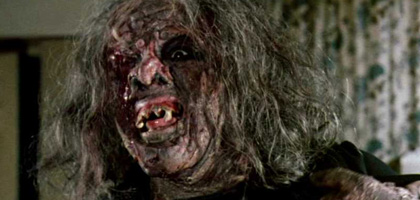American Mary is about a medical student named Mary, who, when trying to make ends meet, finds a profitable career doing body-modification surgery for people desperate to alter their bodies: identical twins who want to swap limbs; a woman who wants a forked tongue; people who don't like their genitalia; and so on. She is doing so well she quits medical school and goes to work full-time as an underground surgeon. And she has another secret: she is getting diabolical revenge on Dr. Grant, a surgeon who raped her, She performs 14 hours of surgery on him, without anesthesia, hacking off his arms and legs, sewing his mouth shut, and keeping him locked up until she can think of more things to do to him.

Mary qualifies as a deformed-destructive being (DDB) if only for the cruelty of the revenge she takes on Dr. Grant, putting herself in the category of rape-revenge horror movie vixens such as Jennifer, the star of I Spit on Your Grave. About her other surgeries, however, there is some uncertainty. Is it truly destructive to cut up and deform a body when the owner of the body wants it done and is willing to pay for it? Perhaps not, if one considers it from the point of view of American capitalism (as the title of this movie suggests). Americans highly value the right of the individual to the pursuit of happiness, and what will make these patients happy is bod-mod surgery. Further, the sanctity of private economic transactions is what the USA is all about, and Mary is engaging in such transactions with her patients. So, from that point of view, she is not a DDB for being a bod-mod surgeon.
Still, if one believes there is a natural order to things, and that destroying parts of a human body and deforming it for non-medical reasons is a violation of that order, then Mary is a DDB just because of the body modifications she carries out. This is why viewers of this film cringe when she carries them out: belief in a natural order is deep inside us, deeper even than capitalism. There are at least two warring final vocabularies at work in this movie--American capitalist and medieval great chain of being--and the clash of them produces the uneasy mix of horror and humor that this film skillfully delivers.
The other film I recently saw, Survival of the Dead, is neither as inventive nor as horrifying as American Mary.

This is the sixth film in the George A. Romero series that began with Night of the Living Dead, and enough is enough. Even the original Planet of the Apes series only lasted for five films. The shambling, ravenous zombies are at it again, this time trying to eat a military unit and two warring families on Plum Island. The film moves right along and is, as were the earlier films, entertaining (except for Diary of the Dead, which was not), but there is nothing substantially new here, and the stakes are low. It's essentially a Hatfield and McCoy film, and who really cares which side of that struggle won?
The DDBs in Survival of the Dead, are, I suppose, the zombies, but by this point they have only a faint supply of deformity and destructiveness. We have seen them many times before, in this series and its many imitators, and we know how to kill them and avoid them. The horror is all but gone. It's like what happened to the Frankenstein monster by the time Abbott and Costello met up with him in Abbott and Costello Meet Frankenstein.
At the end of the film there's a bit of social satire about the futility of war. This bit is itself futile. You don't make six movies about zombies vs. humans if you really think violent conflict is futile. On the contrary, it can be quite lucrative.
George Ochoa




